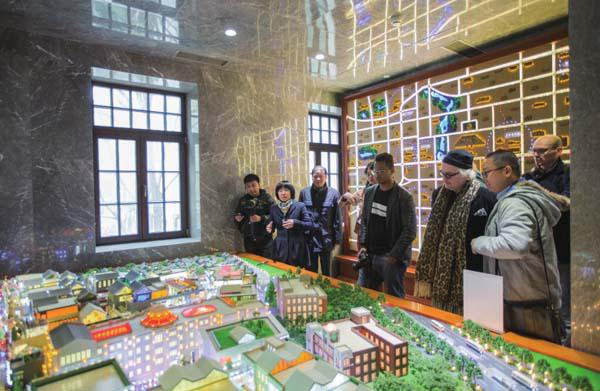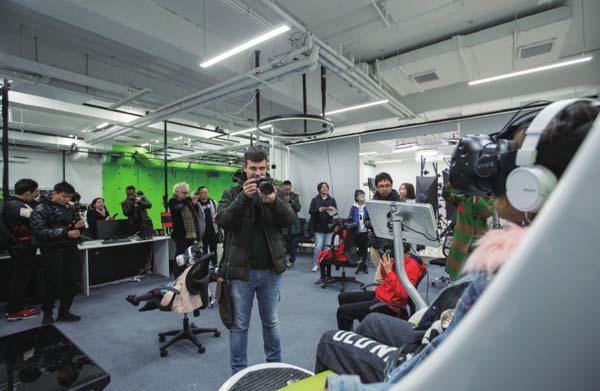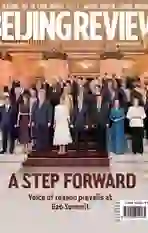From Old to New
2018-12-18ByJiJing
By Ji Jing

Eleven Web celebrities, photographers, and singers from nine countries along the Belt and Road invited by the Information Offi ce of the Beijing Municipal Government took part in a tour of the capital citys cultural landmarks in November 15-17. This event was aimed at introducing Beijings achievements in cultural heritage preservation, public cultural services, and cultural and creative industries over the past four decades of reform and opening up.
Those guests applauded the rejuvenation of the historical communities, believing they are successful combinations of historical buildings and modernization.
“One of the most difficult tasks for urban planners is how to maintain architectural integrity and the charm of older quarters. When building or adapting structures for contemporary purposes, the streetscapes require integrity but not uniformity,” said Digby Wren, a visiting scholar in international relations and communications at Sichuan Normal University from Australias Deakin University, commenting on the rejuvenation to Beijing Review.
Creations in hutong
Cultural and creative industries are flourishing in the historical Qinglong Hutong (Alleyway) in Beijings centrally located Dongcheng District.
“China has long understood the importance of the cultural and creative industries. However, it is only in the past few years that integrated campaigns to protect, promote and produce culture as an essential element of social cohesion and economic progress have taken hold,”said Wren.
The rejuvenation of Qinglong Hutong is in line with Beijings ambition to build a national cultural center. The value of Beijings cultural and creative industries reached 390.88 billion yuan ($57 billion) in 2017 and the number of cultural companies exceeded 254,000 and has become an important driver of growth for the capitals economy, according to statistics from the Beijing Municipal Government in August.
One of the most successful enterprises to open in the area is the Beijing Academy of Creative Arts (BACA), which specializes in preparing Chinese students for studying art abroad. The center opened this August.
Josiah Liu, Marketing Director of BACA, said BACA chose to establish the studio in the area because of its rich cultural heritage as well as its role as one of the host sites of the 2018 Beijing Design Week.
Just a few years ago, the area was dirty and run-down with nothing more than a few local restaurants and small grocery stores. The hutong underwent a substantial renovation project jointly carried out by the Beijing Gehua Cultural Development Group, Beijing Dongcheng District Government and a Danish architecture and urban design enterprise, Archiland International.
The Danish capital Copenhagen was cho-sen as the guest city for the 2018 Beijing Design Week. Guest cities are known for sending a special gift and Copenhagen, which is known for its sustainable technologies, decided to send a city renovation project. The cooperation agreement for the Qinglong Cultural Innovation Community project was signed in September 2017.
The first phase of the project, which focused on improving the overall environment of the 1,220-meter main street, finished in September this year. Previously, the hutongs streets were occupied by vehicles. They have been relocated to nearby underground car parks. Cables which used to run overhead in a web of twisted wires are now underground.
Danish designers have created several triangular gardens where green spaces, benches and exercising facilities have been added to provide a venue for local residents. The toilets have also been refurbished with the addition of a unisex toilet.
“Denmark boasts advanced technologies in old city renovation. They provided us with environmental protection technologies and we built the project together,” said Liu Bing, General Manager of the Innovation Center of Gehua.
Gehuas office offers panoramic views of the hutong. Liu said in the next phase of the project, some local residents will be voluntarily relocated to public housing.
“The ideal situation should be 50 percent of the area for living, 35 percent for industry and 15 percent for commerce,” said Liu. A ChinaDenmark innovation center will also be built to the west of Gehua Plaza during the second phase. The center will demonstrate environmental protection technologies. The building itself will be built with green credentials, with its energy consumption conspicuously lower than a typical offi ce buildings in Beijing.
“Our goal is to improve the environment and infrastructure, using modern technology to make it more suitable for entrepreneurs to work in and local residents to reside,” said Liu.
New fun in Beijing Fun
Qinglong Hutong is not alone in Beijings efforts to preserve historical and cultural areas. The Beijing Fun commercial area, formerly Dashilar, has a 600-year history and has become a new landmark in the capital city.
Situated 100 meters southwest of Tiananmen Square, the planning started in 2006 with renowned architect and city planner Wu Liangyong serving as its chief consultant. Following the principle of preservation while building new structures, the first phase of the project was fi nished in 2016. Occupying an area of 33,000 square meters, Beijing Fun is made up of three old buildings and 14 new ones designed by different architects to enhance diversity.
Beijing Fun “is an excellent example of what is old is new again,” said Wren, pointing out that rejuvenation of Beijing Fun is “suc- cessful in every way.”
Quanye Chang located at the center of Beijing Fun was a four-story European-style building first built in 1905 and rebuilt in the 1920s. It was the most prosperous and fashionable commercial building in Beijing in the 1920s and 1930s. It has been transformed into a cultural and artistic center for exhibitions, lectures and forums. Other buildings in the area cannot be higher than Quanye Chang, which is the center of the project.
“The buildings have their own distinctive styles. Balconies were created on top of the buildings to allow visitors to view the surrounding historical and cultural areas,” said Cao Hui, director of planning and design of the Beijing Fun project.
With an underground parking lot which can accommodate 500 vehicles, no cars are permitted in the area overground. A number of famous brands have set up shop there including the worlds second Muji Hotel, the worlds largest Starbucks and the 24-hour PageOne bookstore.
“Nothing attracts tourists and workers more than the ability to walk safely and enjoy immediate access to modern conveniences especially when the historical streetscapes and charming narrow lanes are clean, the buildings renovated and the charm maintained,” Wren added.
